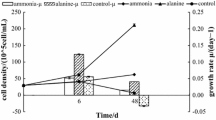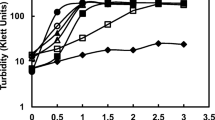Abstract
Nutrient requirements of a red tide flagellate,Chattonella antiqua, were investigated in a laboratory culture experiment. Growth ofC. antiqua was supported by nitrate and ammonium, and by urea to a limited extent, but not by glycine, alanine and glutamate. Orthophosphate served as a good phosphorus source but glycerophosphate did not. Fe3+ (1µM) fully promoted the flagellate's growth in the presence of 80µM of EDTA. The addition of Mn2+ (0–20µM), Zn2+ (0–10µM) and Co2+ (0–0.4µM) did not show any effect. Among three vitamins tested, only B12 (6 ng 1−1) served as a growth factor. Glucose, acetate and glycolate did not improve growth in the light nor did they support growth in darkness. The minimum cell quotas for nitrogen, phosphorus, iron and B12 were estimated to be 11 pmoles ce−1, 1.0, ∼0.09 and 1.1 fg cell−1, respectively.
Similar content being viewed by others
References
Anderson, D. M. and F. M. Morel (1978): Copper sensitivity ofGonyaulax tamarensis. Limnol. Oceanogr.,23, 283–295.
Endo, T., H. Koyama and H. Imabayashi (1982): Phytoplankton in Harima-Nada in relation to oceanographic conditions, particularly nutrient and physiological properties of seawater. In: Fundamental Studies on the Effects of Marine Environment on the Outbreaks of Red Tides. The Ministry of Education, Science and Culture, Japan. B148-R14-8. p. 81–92 (in Japanese).
Guillard, R. R. L. and D. Cassie (1963): Minimum cyanocobalamine requirements of some marine centric diatoms. Limnol. Oceanogr.,11, 410–413.
Hata, Y. and T. Nishijima (1982): Distribution of aerobic heterotrophic bacteria and B group vitamins in Harima Nada. In: Fundamental Studies on the Effects of Marine Environment on the Outbreaks of Red Tides. The Ministry of Education, Science and Culture, Japan. B148-R14-8. p. 109–120 (in Japanese).
Iwasaki, H. (1971): Studies on the red tide flagellates IV. OnEutreptiella sp. andExuviaella sp. appeared in Bingo-Nada, the Seto Inland Sea, in 1970. J. Oceanogr. Soc. Japan,27, 152–157 (in Japanese).
Iwasaki, H. (1979): Physiological ecology of red tide flagellates. In: Biochemistry and Physiology of Protozoa. Vol. 1, ed. by M. Levandousky and S. H. Hutner, Academic Press, New York, p. 357–393.
Iwasaki, H. and K. Sasada (1969): Studies on the red tide flagellates. II. OnHeterosigma inlandica appeared in Gokasho Bay. Bull. Jap. Soc. Sci. Fish.,35, 943–947 (in Japanese).
Lehman, J.T., D.B. Botokin and G.E. Likens (1975): The assumption and rationales of a computor model of phytoplankton population dynamics. Limnol. Oceanogr.,20, 343–364.
Matsunaga, K., K. Igarashi, I. Kudo and S. Fukase (1982): Osaka-wan Yodo-gawa kako ni okeru jukinzoku nodo. In: Proc. 1982 Spring Meet. Oceanogr. Soc. Japan. p. 144 (in Japanese).
Nakamura, Y. and M.M. Watanabe (1983): Growth characteristics ofChattonella antiqua. Part 1. Effects of temperature, salinity, light intensity and pH on growth. J. Oceanogr. Soc. Japan,39, 89–93.
Nakamura, Y., M. M. Watanabe and M. Watanabe (1982): The effect of various environmental factors on the growth yield of red tide algae. I.Chattonella antiqua. Res. Rep. Natl. Inst. Environ. Stud., No. 30, 53–70 (in Japanese).
Okaichi, T., S. Montani and T. Ochi (1982): Marine environment studies on the outbreaks of red tide due toChattonella antiqua (Hada) Ono in the Harima-Nada. In: Fundamental Studies on the Effects of Marine Environment on the Outbreaks of Red Tides. The Ministry of Education, Science and Culture, Japan. B148-R14-8. p. 93–108.
O'Kelley, J.C. (1974): Inorganic nutrients. In: Algal Physiology and Biochemistry, ed. by W. D. P. Stewart, Univ. California Press., Berkeley and Los Angels, p. 610–635.
Ono, C. and T. Takano (1980)Chattonella antiqua (Hada) comb. nov., and its occurrence on the Japanese coast. Bull. Tokai Reg. Fish. Res. Lab.,102, 93–100.
Provasoli, L., J. J. A. McLaughlin and M. R. Droop (1957): The development of artificial media for marine algae. Arch. Mikrobiol.,25, 392–428.
Rhee, G-Y. and J. Gotham (1980): Optimum N:P ratios and coexistence of planktonic algae. J. Physiol.,16, 486–489.
Strickland, J.D.H., O. Holm-Hansen, R.W. Eppley and R.J. Linn (1969): The use of deep tank in plankton ecology. I. Studies of the growth and combination of phytoplankton crops at low nutrient levels. Limnol. Oceanogr.,14, 23–34.
Author information
Authors and Affiliations
Additional information
Dedicated to Prof. Munenao Kurogi on the occasion of his academic retirement.
Rights and permissions
About this article
Cite this article
Nakamura, Y., Watanabe, M.M. Growth characteristics ofChattonella antiqua . Journal of the Oceanographical Society of Japan 39, 151–155 (1983). https://doi.org/10.1007/BF02070258
Received:
Revised:
Accepted:
Issue Date:
DOI: https://doi.org/10.1007/BF02070258




